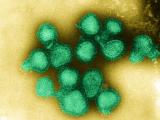Sep 10, 2010
WHO: Chile reports late-season flu spike
The World Health Organization (WHO) announced today that in the wake of its August move to a post-pandemic period it will no longer post weekly flu situation reports on its disease outbreak Web site. The WHO said it is still monitoring global flu activity and will post updates every other week on the Global Alert and Response section of its Web site. In today's update the WHO said the most active areas of flu transmission are in the temperate regions of the Southern Hemisphere and southern Asia. Over the past 2 weeks Chile has reported a sharp increase in flu activity, which is unusual, because the country typically experiences a respiratory-disease peak in June and July. Influenza is affecting all age-groups, though rates are lower in seniors. Most of the flu activity involves the 2009 H1N1 virus, but officials are noting a recent shift toward influenza B and influenza A/H3N2 viruses. India is still reporting active 2009 H1N1 transmission nationwide, with a substantial number of fatalities occurring in several states. Australia has reported increasing levels of 2009 H1N1 activity in August and September, though emergency department visits for flu-like illnesses seem to be leveling off. In New Zealand flu activity is decreasing, though rates are still above national baselines. Meanwhile, the Central African Republic reported its first 2009 H1N1 detection.
Sep 10 WHO notice on influenza reporting
Sep 10 WHO influenza update
Study suggests flu vaccine reduces adult hospitalizations
A California research group, hoping to shed light on the benefits of flu vaccination in adult populations, has found that immunization has a modest but significant preventive effect on hospitalizations for pneumonia and influenza. The study, published online yesterday by Vaccine, used a "difference-in-differences" approach that looked at hospitalization rates among vaccinated and unvaccinated groups when the virus was and wasn't circulating. The researchers also estimated vaccine effectiveness based on different definitions of the flu season. Studies on the benefits of flu vaccines in reducing pneumonia hospitalizations have produced conflicting findings, from no benefit to a 27% reduction. The researchers studied health plan members aged 50 and older over 11 flu seasons starting in September 1997. They found that flu vaccination was linked to a 48% reduction in pneumonia and flu hospitalizations in adults aged 50 to 65, which fell to 28% in seniors. Flu vaccination did not appear to influence hospitalizations for ischemic heart disease, congestive heart failure, cerebrovascular disease, or trauma.
Sep 9 Vaccine abstract
Australia releases national pandemic vaccine uptake stats
Australian health officials today released the results of a survey on the nation's uptake of the 2009 H1N1 vaccine, which shows that about 18% of the population had been vaccinated by the end of February 2010. The rate is slightly lower than the 20.3% estimate of pandemic vaccine uptake in the United States. Compared with the general uptake, rates were higher in Australians with underlying health conditions (34%) and in health and community care workers (29.5%). In a press release, Dr Penny Allbon, director of the Australian Institute for Health and Welfare, said rates varied by state, with Tasmania showing the highest uptake at 23.5% and Western Australia the lowest at 15%. The survey also explored reasons people did and didn't receive the vaccine. The most common reasons for forgoing immunization were the beliefs that the 2009 H1N1 virus wasn't a serious health threat, that the vaccine had flaws, and that vaccination wasn't a priority. The pandemic vaccine was free, available for all groups except babies under 6 months, and available starting in September 2009, which was near the end of Australia's flu season.
Sep 10 Australian Institute for Health and Welfare press release
Full vaccination survey report
Flu vaccine link not firmly excluded in Australian child's death
A coroner in Brisbane, Australia, said he could not rule out a connection between the death of a 2-year-old girl in April and a seasonal flu vaccine she had received a day earlier, the Australian Broadcasting Corp (ABC) reported today. Coroner John Lock said a lengthy investigation failed to pinpoint the cause of the girl's death, but the vaccine could not be "absolutely excluded," according to the story. The child received the CSL vaccine Fluvax. In April Australian authorities advised providers to stop using Fluvax in children younger than 5 because of an unexpectedly high rate of febrile convulsions in those who received it. In June, after further investigations confirmed the increased rates of febrile convulsions, Australia's chief medical officer said the suspension should continue, though no explanation for the adverse events was found. Fluvax contains the 2009 H1N1 virus as well as H3N2 and influenza B viruses.
Sep 10 ABC News report
Experts warn about future global biotech priorities
Though biotechnology companies in developing economies such as India, Brazil, and China have made good progress in creating affordable treatments and vaccines for local populations, the companies may move toward more lucrative products that serve the needs of large corporations and wealthier countries, says a commentary by Canadian researchers at Toronto's McLaughlin-Rotman Center for Global Health in the September issue of Nature Biotechnology. They point out that about 1 billion people suffer each year from neglected tropical diseases and that companies in developing nations are marketing and developing new drugs, diagnostics, and vaccines against the diseases. Dr Peter Singer, director of the center, said in a press release, "Developing country companies are innovating close to the 'coalface' of global health problems, making appropriateness, translation, uptake and affordability of the resulting solutions more likely." He and coauthor Rahim Rezale write that the companies may need to choose between global health and global wealth. They contend that the companies can do both if they institute mechanisms that are not based solely on entrepreneurial models and support product development for the poorest market segments. They propose a set of strategies, such as public-private partnerships, that could help the companies balance their priorities.
Sep 9 McLaughlin-Rotman Center for Global Health press release
Sep Nat Biotechnol abstract



















